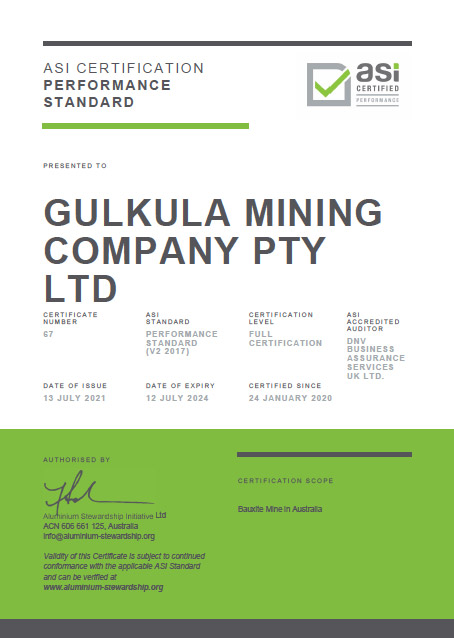Gulkula: The Indigenous Mine Pioneering Sustainability in the Aluminium Supply Chain
 Below, we provide some excerpts from the report to give a flavour of the contents. The full case study has more details on the Gulkula mining model, its ASI Certification outcomes, and how Gulkula is a role model and inspiration for alternative and more inclusive approaches for engaging community members and Indigenous Peoples in all aspects of mining operations.
Below, we provide some excerpts from the report to give a flavour of the contents. The full case study has more details on the Gulkula mining model, its ASI Certification outcomes, and how Gulkula is a role model and inspiration for alternative and more inclusive approaches for engaging community members and Indigenous Peoples in all aspects of mining operations.
Background
Gulkula Mining Company (Gulkula) is the world’s first Indigenous-owned and -operated bauxite mine. Located in East Arnhem Land, in the Northern Territory in Australia, the mine is situated on the Dhupuma Plateau – the traditional land of the Yolngu People. The Gulkula mine is 100 percent owned by the Gumatj clan, one of the Yolngu Traditional Owner groups of East Arnhem Land. Yolngu ancestry traces back more than 65,000 years. Bauxite mining has been practiced on their land and throughout the broader region for over 40 years.
A revolutionary mining model
In early 2020, three years after mining operations commenced, Gulkula became the first Indigenous-owned and -operated mine to achieve ASI Performance Standard provisional certification. This achievement formally declared Gulkula’s commitment to sustainability.
Backed by ASI and IPAF principles, Gulkula develops and executes initiatives that benefit the broader Indigenous community. There are a range of approaches that Gulkula has embedded in its strategies that work to build capacity for Indigenous Peoples, as part of a long-term vision that seeks to maximise the benefit of mining against its impacts.
Outcomes from ASI Certification
 The ASI audit and certification process triggered a review and evaluation of Gulkula’s management and business systems. One tangible benefit was improved discipline in data collection, record-keeping and reporting. This, in turn, informed an internal audit that presented opportunities for refining existing business practices. Subscribing to the principle of continuous improvement, Gulkula has implemented procedures to address identified discrepancies, some examples of which are given in the full case study.
The ASI audit and certification process triggered a review and evaluation of Gulkula’s management and business systems. One tangible benefit was improved discipline in data collection, record-keeping and reporting. This, in turn, informed an internal audit that presented opportunities for refining existing business practices. Subscribing to the principle of continuous improvement, Gulkula has implemented procedures to address identified discrepancies, some examples of which are given in the full case study.
Where to from here?
The Gulkula mine is a demonstration of a new, community-backed model that is leading the way for Indigenous communities’ participation and engagement in bauxite mining. The Gulkula mine demonstrates that through effective collaboration, it is possible to support Indigenous communities in developing mining operations that address their cultural, social, economic, and environmental needs and aspirations. As a member of ASI, Gulkula enables other member organisations to learn from their own experiences in how mining can empower Indigenous communities. By actively engaging in ASI activities, it is anticipated that Gulkula’s model may be emulated by other members.
The Gulkula operation is a demonstration of a mining model that can build a more sustainable aluminium industry – one that uses alternative and more inclusive approaches for engaging community members and Indigenous Peoples in all aspects of mining operations. The Gulkula model gives hope to Indigenous people regionally, nationally, and globally.
More information
- Consult the full case study
- Consult Gulkula’s Performance Standard Summary Audit Report
- Consult Gulkula’s Member page


